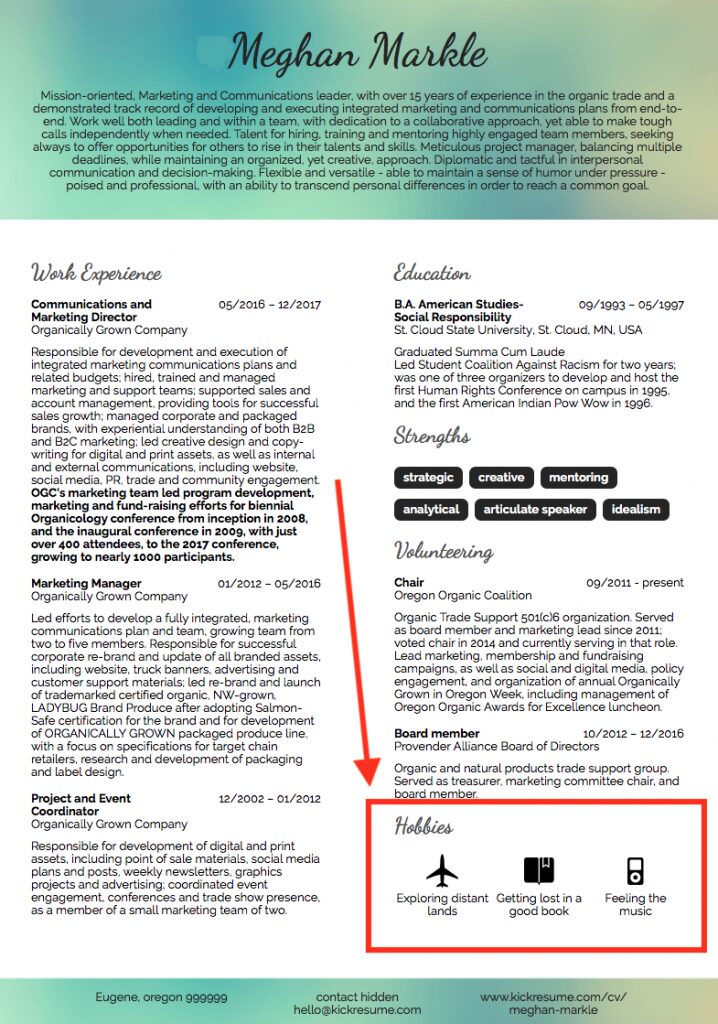Everyone wants to be a marketer. And why not? Contemporary and comfy office spaces, talented teams and the flexibility to try new things are enticing perks. But since so many people want to be in marketing, there’s a lot of competition out there.
Whether your goal is to work with global brands or you like the intimacy of a small startup, you’ll want your marketing resume to be the best it can be. Today’s companies know how important marketing is to their success, and they want to hire the cream of the crop.
Your resume has to sell itself – or, more appropriately, sell you – to the recruiter, department head or CEO. Content and layout are equally important – you have to include the best information in the most appealing format possible.
The Basic Layout of a Marketing Resume
For the most part, marketing resumes include the following sections. Don’t worry about structure or layout right now – do that last, once you’ve gathered all of your info:
- Objective / Profile / Summary: Modern resumes have a profile or a summary, but you can opt to skip this part, especially if you have extensive work experience to squeeze onto one page.
- Marketing Experience (or “Work Experience”)
- Education: This section can be toward the bottom of the resume if you graduated years ago and/or if your degree isn’t relevant to marketing.
- Soft Skills
- Technical Skills: You can combine this with soft skills for a general “Skills” section if that looks better.
- Certifications: If you have a couple of certifications, it’s fine to mention them in the profile section of the resume. More certifications call for their own section, though.
- Hobbies / Interests
Remember, not every marketing job is for a creative company. Find out the company’s culture before you move forward with the rest of your resume. If you’re applying to the marketing department at a bank or law firm, they won’t appreciate a vibrant resume – keep it classic.
While many of the suggestions below are for a more creative resume rather than a traditional one, it really depends on the type of organization. For example, an employer that requires long workdays doesn’t care about your hobbies, and they may even view them as distractions.
Be Selective When Choosing What to Include
Unless you have limited work experience, you should pick and choose what to include in your resume. This is true for all resumes, no matter the industry. When it comes to marketing, though, you’ll want to do the following:
- Show the varied work you’ve done
- Highlight your most creative and/or effective campaigns
- Showcase your specialties
- Make sure your experience matches what the role requires
Definitely include buzzwords and phrases from the job description. Also, add any marketing-specific phrases that you believe the employer is looking for. For example, include the names of the social media platforms, CRM systems and software programs you use. Tweak your job titles to include more keywords, so long as the changes don’t make you seem like you had a different or higher position than you did. Update those job titles on LinkedIn, too.
When it comes to your resume-worthy marketing campaigns, don’t try to list each and every successful campaign you ran. You can always have a digital and/or hard copy portfolio with more examples for employers who are interested. Also, instead of listing your campaigns in bullet point format, present them in a way that showcases just how special they were – use them as examples to flesh out hard skills or add depth to stats.
Emphasize Your Experience with Numbers
Quantifying your successes sets you apart from everyone else who has the same generic experience as you. How many people were on the team you managed? What were the stats from a successful campaign you ran? How much money did you bring in thanks to a promotion? When including stats, talk about the “how” along with the “what.” Instead of, “Increased newsletter clickthrough rate by 40%,” write, “Increased newsletter clickthrough rate by 40% after A/B testing calls-to-action.”
Marketing tactics are learnable – there are endless guides and courses, many of them free, to learn the ropes. Doing it well is another story, though, and you’ll be hired based on your successes and results more than your hard skills. Yes, you can manage a Twitter account. But how did that Twitter account grow under your management at your last job?
Of course, you should still mention your relevant hard skills even if you don’t have specific examples, especially if you’ve learned a technique that a lot of other marketers don’t know yet. For example, Snapchat has a young audience, and brands that cater to older audiences didn’t bother with it. Then Stories came along for Instagram and Facebook, opening up the format to a broader, older audience. Marketers who had Snapchat skills were suddenly more in-demand.
Don’t Be Afraid to Be Creative
Marketing is a highly creative job, and you can show off a bit of creativity on your resume. Use an unusual (yet still readable) font for the section headers – just stick to standard fonts (Arial, Times New Roman, Verdana) for the rest. Add pops of color for visual appeal, so long as they’re not distracting.
The hobbies section on the first resume below is cute and unexpected, and while you don’t need a hobbies section, if you’re going to include one, this is an out-of-the-box option. (By the way, the rest of this resume is way too cluttered, so don’t use it as an example.) You can also use icons throughout your resume to illustrate sections or points.
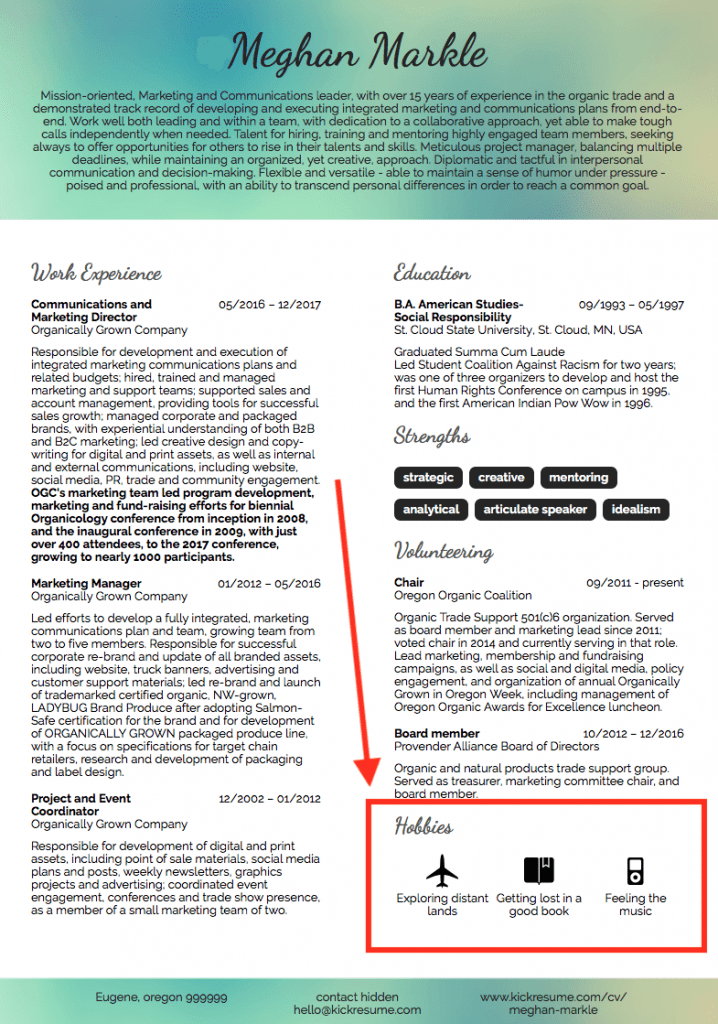
Source: Kickresume
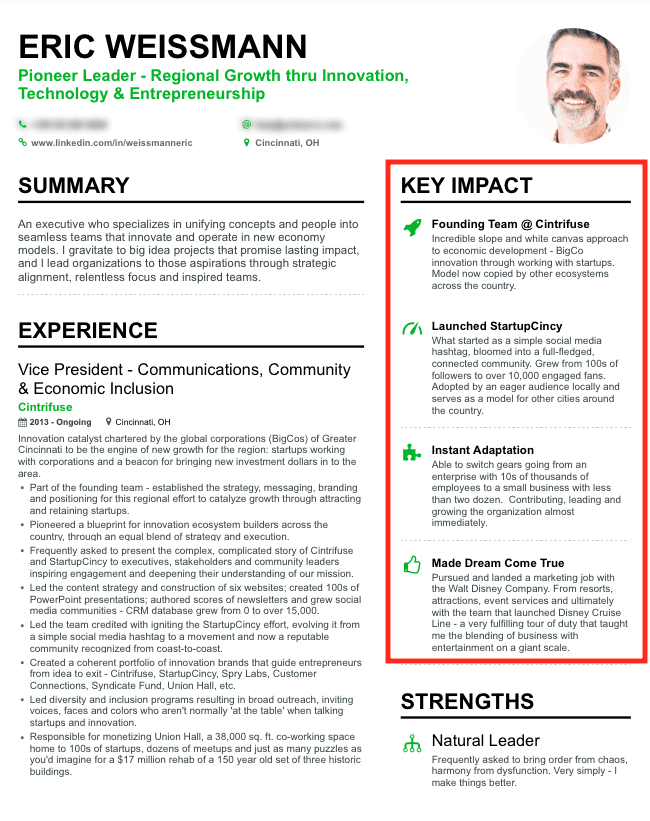
Source: Enhancv
One word of warning: even if you get a bit artistic with your resume, do not create an infographic resume. Even if yours is clear, infographics take a minute to adjust to, and hiring managers don’t have a minute – they assess your resume in just a few seconds. If you want to, create an alternative infographic resume that you put on your website or in your portfolio to show off your design skills.
Match the Style to the Brand
Creating a resume that complements the company’s branding shows that you know what you’re applying for while also showing off your skills. You can go bold and modern, like the colorful resume below, or tongue-in-cheek, like the resume with the thumbprints for verification. You’re not copying the company’s branding; you’re showing that your taste and style line up with theirs.
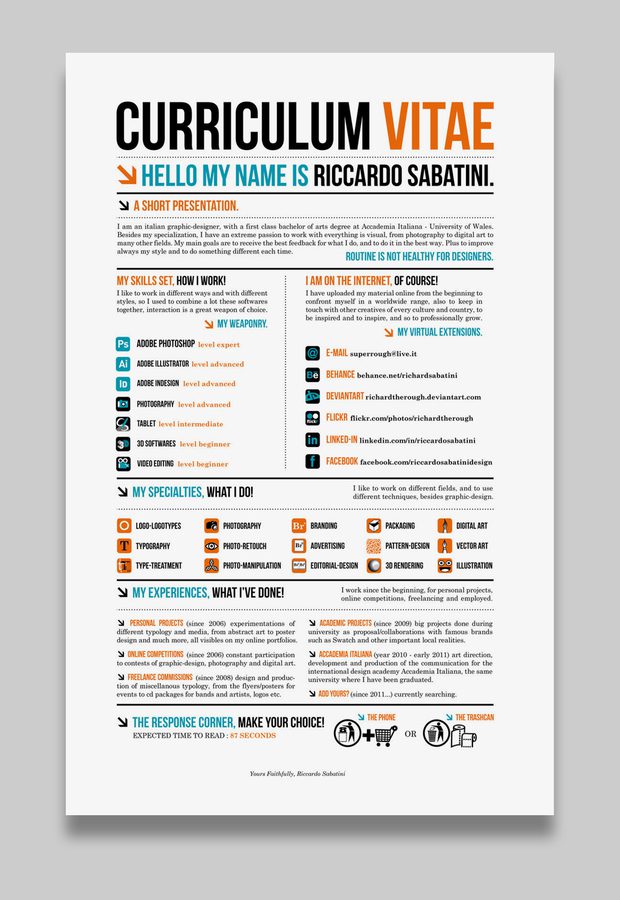
Source: Skillroads
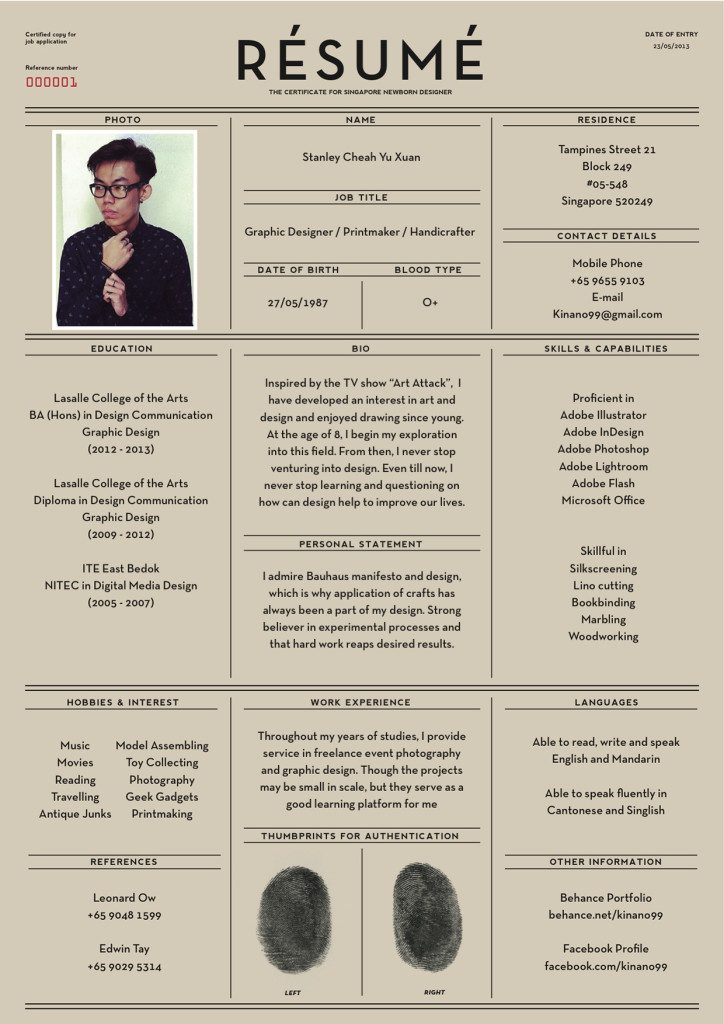
Source: Skillroads
Match Your Voice to the Brand, Too
Marketing is a voice-centric field, and everything you create will have to be in the voice of the brand. Your resume gives you the opportunity to show that you can emulate that voice. Read their website and check out their social media profiles first, then adapt your voice to meet the brand.
Take Buffer as an example. They have a notably warm, approachable voice, and it shines through on their social media even more than their website. In the Facebook post below, they use “very,” which means their writing isn’t stuffy (“very” is a no-no in academic writing), they use personable words like “friends” and “fantastic,” and they use emojis in their posts. You don’t want to put emojis in your resume, but now you know that you can (and should) write in a more casual tone.
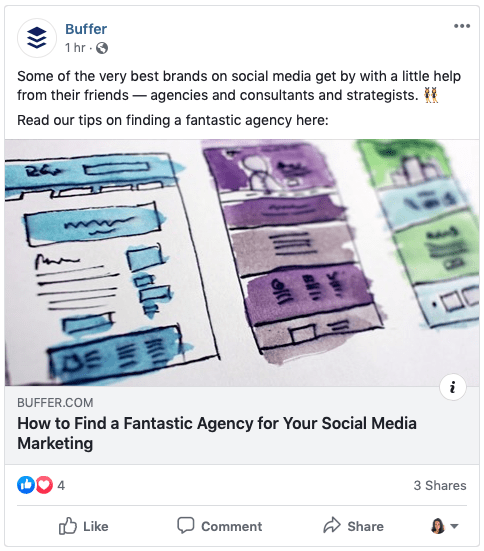
Show Them What You Look Like
In today’s hyper-engaged world, marketers won’t necessarily stay behind-the-scenes. You may be face-forward in a marketing position at a new company, and it’ll help if your interviewer can see what you look like ahead of time – not to judge you, just to put a face to the name, like the brand’s audience will do at some point (should you land the job). Depending upon the company you’re applying to, your photo can be a traditional headshot or something more casual like this:
Source: Kickresume
Now, adding a photo to your resume is a hot-button topic. Some people feel like it can lead to discrimination or favoritism. Consider the company and position you’re applying for, but if you want to include a photo, it’s not a hard “no,” since plenty of people do.
7 Resume Rules to Remember
These tips can apply to all sorts of resumes, but they’re worth a refresher:
- Only include your last 3-4 jobs, and list them in reverse chronological order (start with the most recent job). If you’ve worked at one company for several years, list each position separately (assuming they had different responsibilities). You can use LinkedIn to dig deeper into your work history, should anyone want to see it.
- Speak in the first person without using “I.” Write the sentence, then just remove the “I” (or the “my”). “I manage the Facebook account for Company X,” becomes, “Manage the Facebook account for Company X.”
- The more experienced you are (and the more senior a position you’re after), the wordier your resume can be. You have a lot of experience and you need to share it. When you have a wordy resume, the format is even more important than normal, because it still has to be skimmable and easy to read instead of cluttered and overwhelming.
- Limit your resume to one page unless you absolutely cannot fit everything and you’re advanced in your career. Hiring managers either like you by page one and don’t need page two or they aren’t interested and they won’t get to page two at all. You can adjust font sizes, spacing between letters and lines, and margins to get more onto one page.
- Use the profile section wisely. In 2-5 sentences, mention what’s most important about your work experience and what you need the hiring manager to know and remember. Maybe it’s a global brand you worked for, a marketing campaign you created that went viral or the fact that you speak several languages.
- Submit your resume as a PDF instead of another format. When your resume is processed via the employer’s computer system, characters, formatting and spacing can change if it’s a non-PDF file; PDFs should stay the same across-the-board, though.
- Do not turn in a resume with spelling or grammatical errors. Marketing is a field that requires attention to detail.
Creating a Marketing Resume Without Experience
What happens if you have next-to-nothing experience? If you’re a recent graduate or you’re hoping to switch careers, you may not have a lot of on-the-job knowhow, but what you do have is passion. You also have soft skills and maybe even relevant life experience. Highlight those strengths, and still include your education, internship and work history. You’ll show that you can commit to hard work and are self-motivated, even if you haven’t been a marketer yet. Play with the structure of the resume, too – your education or volunteer experience can be listed higher if it’s more relevant than your work background.
If your resume still looks a little thin, take some certification courses, like the Social Marketing Certification from Hootsuite Academy or YouTube’s certified program. Many are free, and they can help you gain a competitive advantage.
Wrapping Up
Marketing jobs are demanding and your resume has to live up to that. You have to show your creative side and your professionalism, the artist in you and your penchant for facts and hard numbers. This is your specialty, though. You know how to present something in an appealing way – you’ve created ads for products, press releases for events, landing pages to convert leads. You already know how to do this, and the only difference is that now you’re your own client. Prune your experience to highlight your best work examples, brag about your top marketing campaigns and use your SEO savvy to include the keywords that hiring managers and resume software will look for.
When your resume does its job and gets you closer to your future job, it’s time to prepare yourself for a marketing interview. Here’s how.
Featured image via VectorKnight / shutterstock.com
The post Everything You Can Do to Make Your Marketing Resume Stand Out appeared first on Elegant Themes Blog.

